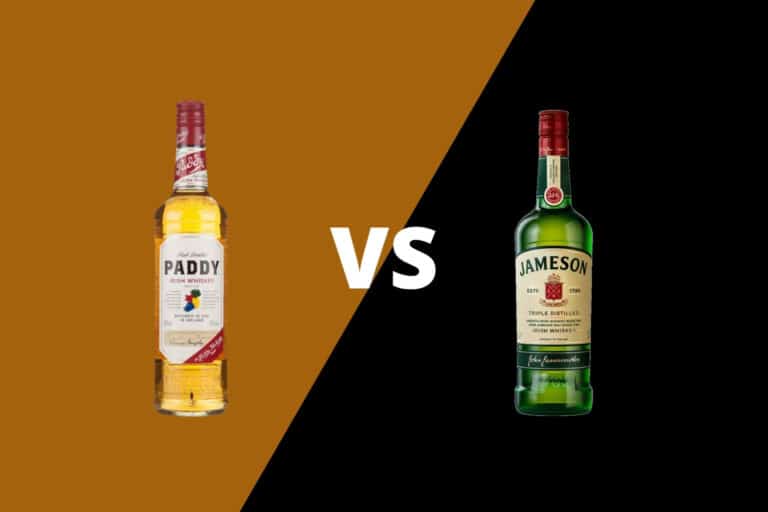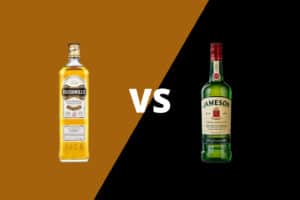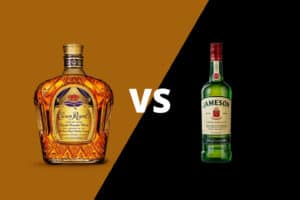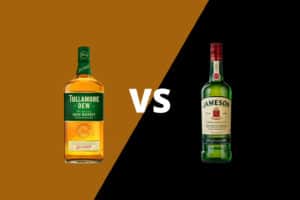Welcome to our Irish whiskey introduction to two powerhouse brands: Jameson and Paddy Irish whiskeys.
Today, we’ll explore what to look for when comparing these two historic brands. Whether you’re a professional beverage director or a budding enthusiast, our goal is to help you understand the science behind the label so you can make informed choices when you pour.
Let’s dive in!
Table of Contents
History
When I began writing about the whiskey industry in 2013, it became apparent the seemingly simple question ‘What is the most popular Irish whiskey?‘ was a bit more complex than one might expect.
It was no surprise that the No. 1 selling brand in terms of global sales volume was Jameson — a brand synonymous with the Irish whiskey category. However, the brand that sold the most in Ireland was Paddy’s — a brand that wasn’t available in the United States at the time.
It made a man wonder — what do the Irish know about Irish whiskey this American is ignorant of?
The story of Paddy began when the North Mall Distillery first began producing whiskey in County Cork in the south of Ireland in 1779. It was later acquired in a merger to become part of the Cork Distilleries Company and produced various products, including the Map of Ireland brand of whiskey. The distillery was merged with three other entities to create the Cork Distillers Company in 1867.
The Jameson Distillery was also founded in 1779 in Dublin. At that time, many breweries and distilleries in the area used the high-quality stone-filtered subterranean water source that flowed beneath the city’s streets. John Jameson opened the distillery shortly after marrying into the powerful Haig family, who owned several scotch whisky interests throughout the United Kingdom. By 1805, the Jameson brand was the No. 1 Irish whiskey in terms of global volume sales — a crown it maintains to this day.
Those in the booze business know that brand representatives are the backbone of the industry.
The Paddy name is tied to a brand rep. Patrick Flaherty was so keyed into the brand’s sales that upon his retirement in 1913, they decided to name the Map of Ireland whiskey after him.
The answer to the question ‘What’s the best Irish whiskey in Ireland?‘ is obviously open to subjective personal preference. But Paddy’s nod as 2020’s Gold Medal winner in the Blended Irish Whiskey category at the 2020 International Whisky Competition gives it a peg on which to hang its hat.
Mashbills
Both Jameson and Paddy’s are blended Irish whiskeys made by combining the separate Irish whiskey sub-types made by Irish distilleries, including grain, malt and pot still whiskeys.
Grain whiskey describes a sub-category of Irish whiskey that can be made from a mash of any combination of grains. By tradition and practice, these whiskeys are traditionally made from a majority of either corn or wheat. The preference between the two often comes down to international grain commodity prices, with the cheaper of the two being chosen to reduce input costs. A portion of malted barley is also added to a grain whiskey mash to induce the saccharification of grains during the cooking phase.
Malt whiskey is made from a mashbill of 100 percent malted barley. If it is made in a single distillery, it can be called a single malt whiskey — similar to the regulations that govern the more recognized single malt industry in Scotland.
Pot still whiskey is a style of whiskey native to Ireland produced from a combination of malted and unmalted barley grain, with each type of grain consisting of at least 30 percent of the total mash bill.
Blended whiskey is a sub-category made from any combination of these types of whiskeys.
Both Jameson and Paddy’s are blended Irish whiskeys. But a significant difference between these two brands is that Paddy’s is a combination of grain, malt and pot still whiskeys, while Jameson is a combination of grain and pot still whiskeys.
Distillation & Production
Both whiskeys are produced at the Midleton Distillery in County Cork.
Irish Distillers produces Paddy for the Sazerac Company. The Jameson name is produced and distributed by Irish Distillers, a subsidiary of Pernod-Ricard.
This is a great time to discuss triple distillation.
The term ‘triple distillation’ has become synonymous with Irish whiskey production. And while most whiskey exported from the island is triple distilled, it’s important to note that Irish whiskey brands are not required to triple distill their products to be considered an Irish whiskey.
However, both Jameson Irish whiskey and Paddy Irish whiskey are triple distilled.
In the heyday of Irish whiskey during the 18th and 19th centuries, Irish whiskey was considered the most refined whiskey available and preferred by international palates to products such as American bourbon whiskey, Canadian Rye whiskey and Scotch whisky. Before the invention of the Coffey still — the predecessor of the modern column still — all whiskey was produced using a traditional copper pot still. These large copper pots heat the alcoholic beer-like wash to the point where the alcohol vaporizes away from the non-alcoholic liquids and rises to the Lyne arm before reaching a condenser where it is cooled back into a liquid state.
The large whiskey production centers in Ireland utilized massive copper pot stills and crafted the art of triple distillation — distilling the liquids three times as opposed to the more traditional and cost-effective double distillation. The extra distillation gave Irish whiskey a smooth, mellow and refined flavor profile appreciated throughout the whiskey-drinking world.
But when Irishman Aeneas Coffey patented a device that pioneered column distillation in 1830, that dynamic was forever changed. Now, producers could utilize a modern approach and an energy-efficient technique to reduce the costs of spirits production. And as producers in Scotland, Canada and the United States embraced the new technology, many in Ireland were reluctant to change the formula that had given them the lion’s share of whiskey drinkers.
For an in-depth look at modern triple-distillation techniques, check out our Crown Royal vs Jameson post.
Maturation
Once clear new make spirit is produced, it is time for the next ingredient — oak casks — to impart their signature flavor and color to the liquid.
The most common cask type used in most international whiskey — including Canadian, scotch and Irish — is used bourbon barrels. These are inexpensive on the secondary market due to the requirement that American bourbon and Tennessee whiskeys be matured new oak barrels. Often, products are aged in bourbon or Tennessee barrels, and then moved to a rare container like first-fill sherry casks for secondary maturation.
Paddy’s Irish whiskey was once offered as a 10-year age statement whiskey, which guarantees that any barrel used in the barrel is aged for a minimum of that long. However, it no longer has an age statement on the label.
Jameson has no age statement.
Ownership, Price Point & Value
Paddy’s Old Irish Whiskey is a product of Sazerac, a growing international drinks business based in New Orleans, Louisiana, with a considerable corporate presence in Kentucky. Sazerac purchased the brand in 2016 from Pernod Ricard’s Irish Distillers company. At the time of the sale, Paddy’s was the No. 4 selling brand of Irish whiskey on the global market.
Paddy’s can be purchased at a retail price of about $20 for a 750mL bottle at 80-proof, or 40 percent alcohol by volume. Its entry into the global marketplace coincided with a bump in price. It has recently been rebranded to a premium product, elevating it from its decades-long value proposition.
Paddy’s packaging includes a cardboard gift sleeve as well as newspaper-like packaging. These packaging presentations are often bemoaned by whiskey fanatics as a precursor to a price range.
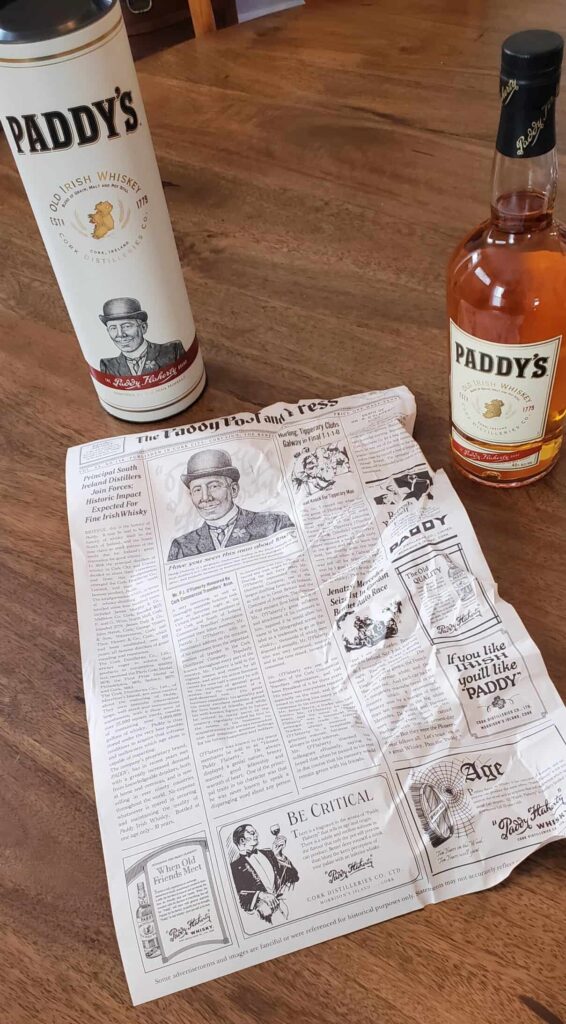
But in the case of Paddy’s, the packaging offered a lot of information about the brand. The fictional ‘The Paddy Post and Press’ newspaper print included a bio of the namesake salesman who built a name for himself in the industry. In addition, it included a full page of news copy, complete with ads and even a sports piece about hurling. Quite an impressive feat for the marketing team at Sazerac. Sure it’s marketing copy, but at least it’s interesting.
Jameson is produced by Pernod Ricard subsidiary Irish Distillers. A 750mL bottle at 80-proof will cost about $28.
Tasting Notes
Jameson Blended Irish Whiskey
Description: The color is deep copper, the hue straw-gold. Legs are medium at 80-proof.
Nose: An oak richness, with the aroma of smoky embers. A lingering note of figs.
Tongue: Light and delicate mouthfeel, a bit of oak, gunpowder, mild coconut and white vanilla.
Finish: A finish of charcoal with chocolate and vanilla.
Paddy’s Old Irish Whiskey
Description: In the glass, Paddy’s has a hue of straw-gold, and the color of burnished copper. Legs are moderate at 80-proof.
Nose: Complex. Nuttiness. Oak. A faint cedar aroma. Black pepper notes. Marzipan, nougat, honey, vanilla, toffee and caramel. Lingering aromas of malty cereal.
Tongue: Smooth and elegant. Caramel, honey sweetness, vanilla, white chocolate. Mellow.
Finish: Smooth and light. Vanilla, chocolate, baking spice, leather.
Verdict…
If you’re looking for the perfect St. Patrick’s Day experience, try blind tasting these two amazing whiskeys — along with some other notable Irish whiskeys such as Tullamore DEW, Slaine Irish Whiskey, Green Spot and Teeling.
Paddy’s and Jameson are approachable, everyday whiskeys, perfect for the entry-level Irish whiskey drinker. And if you find yourself drinking whiskey at your favorite pub and in need of an Irish kick — these two brands are a perfect choice.

